The Nao of Brown
I've always had a soft spot for comics, but before I started Good Ok Bad, I was more interested in literary fiction. The Savage Detectives, Wind-Up Bird Chronicle, Never Let Me Go, Franny and Zooey, Cat's Cradle, Foucault's Pendulum, Lord of the Flies, The Great Gatsby, A Tree Grows in Brooklyn. I don't mention these to drop names but to give you a place to hang your hat, a way of knowing what I'm talking about. Maybe you've read all of these. Maybe only one or two. But in either case, you should understand that I'm talking about those literary works of heft (and not necessarily of physical heft) that demand careful reading and even more careful interpretation.
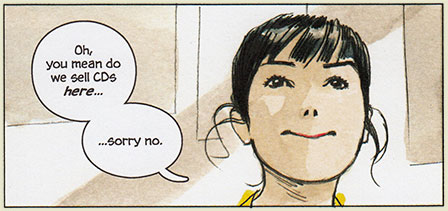 This doesn't have to do with literature. I just found her expression cute and endearing.
This doesn't have to do with literature. I just found her expression cute and endearing.
There was just something in the challenge presented by those books that called out to me in a way that enriched my life. And since beginning Good Ok Bad, I've had to shelve my interest in literary fiction almost entirely.11I did squeeze in 1Q84 when it came out, but it was such a juggling match that I haven't attempted anything of the sort since. I spend all my spare time (after work and family and side work) reading comics for review and then reviewing a handful of those. I read a lot every week and preparing a review takes up at least an evening. And so I've missed my first love: meaty books. Sadly, comics haven't ever risen to the task of filling that void. At least not generally.
Even the best comics are works of genre fiction, fantasies or sci-fi or sci-fi fantasies. Maybe an adventure or a graphic crime novella. There's nothing particularly wrong with that. I adore Nausicaä of the Valley of Wind and think it's one of the best comics I've ever read. But it's no 2666. Not that it has to be, either. There's plenty of room for fiction that is fun and fiction that is hard. It's just, comics has been largely missing the hard stuff for a long time now.
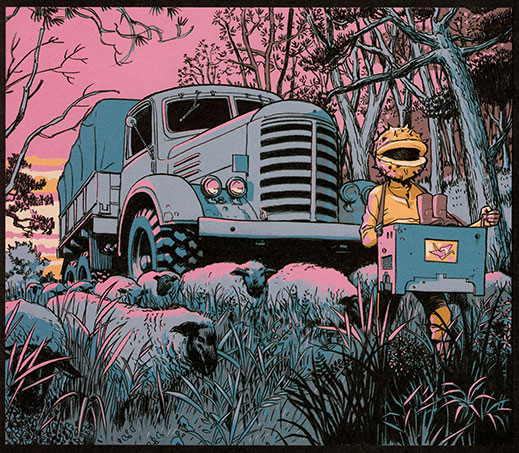
The last few years though have been particularly encouraging to me. There have been more serious works produced in English-language comics22And let's be clear here that I'm talking about American, Canadian, and British comics (and maybe Australian?). My lack of familiarity with non-English-language productions makes it impossible for me to judge there. Though I have been encouraged to know that there's definitely some, I guess, off-the-beaten path serious literature like Jiro Taniguchi's The Walking Man. in the last half-decade than in possibly the entire rest of English-language comics' history.33And let's remember here that I'm talking about fiction. Serious-minded, even outright dour autobiography has been a staple in English-language comics since at least, what, the Seventies?
I mean, look. We've gotten Moon and Ba's Daytripper. Chris Ware's Building Stories (and before that, Jimmy Corrigan). What else? Habibi, Asterios Polyp, Big Questions, Sailor Twain, Mother Come Home, The Arrival, and the work of Nate Powell (Swallow Me Whole and Any Empire). Each of these are huge steps toward comics producing something of literary magnificence. We can see them straining for and even sometimes touching a goal that I hold (even if no one else does) for the medium: that comics would at least in some of its product transcend44And I don't mean transcend in the sense that they should stop being comics. More just in the sense that comics' evolution was retarded for so long that it still struggles against infantalizing its potential. Comics is, in a sense, a ghetto—and wild critical success in comics is often really just an example of big fish/small pond. I want to see comics able to present great cultural artifacts that can stand up with the Beethoven's Fifth Piano Concertos, the Citizen Kanes, the Crime and Punishments. That's what I mean by transcendence. its medium and give the world Literature. With a capital L.
With these works, I could see comics on the cusp. I could see creators growing at an almost unnatural pace toward something amazing. When Duncan the Wonder Dog came out I wondered if we hadn't arrived. The work was complex, filled with allusions, and spoke to something deep within the human experience. I was stunned to hold something in my hands that was exactly what I had been missing from the medium. But a single work is not an arrival. There had to be more. There had to be more creators doing things that were not just good and not just great, but incredible. Two years after Adam Hines' Duncan, Chris Ware's Building Stories was collected and proved my faith in the medium. It really is an astounding work, something that proves the essentiality of comics for certain stories and gives readers a work of complexity and importance. But Chris Ware is a known entity (and not exactly representative of comics as a whole). This is exactly what everyone expected of him. I felt I needed more. Hines was unknown (and sadly remains so, despite crafting such a sublime work) and Ware's star will not cease to shine brightly among the outside-comics literati. What would be the third work and how long would it take to arrive?
As it turned out (at least according to a quick look at Amazon), The Nao of Brown hit American shores the day before Building Stories. It's sad to think that such a beautiful, careful work could be so entirely subsumed in the wave of press for another work (even one that is great and careful itself), but fortunately some people were aware of The Nao of Brown. If it weren't for reading other people who gave the book a shot and thought highly of it, I wouldn't have known it existed in order to give it one myself. And now, like I did with Duncan the Wonder Dog, I'm going to be telling everyone I know that if they want to read a worthy graphic novel, Glyn Dillon's book is what they want to be reading.55My recommendation of Duncan actually went over largely as a lead balloon. Very few of those who gave it a shot actually appreciated it. Some were confused by its complexity, some were too staunchly opposed to message, some thought it was fine but couldn't empathize with my adulation. Here's hoping things go better with The Nao of Brown.
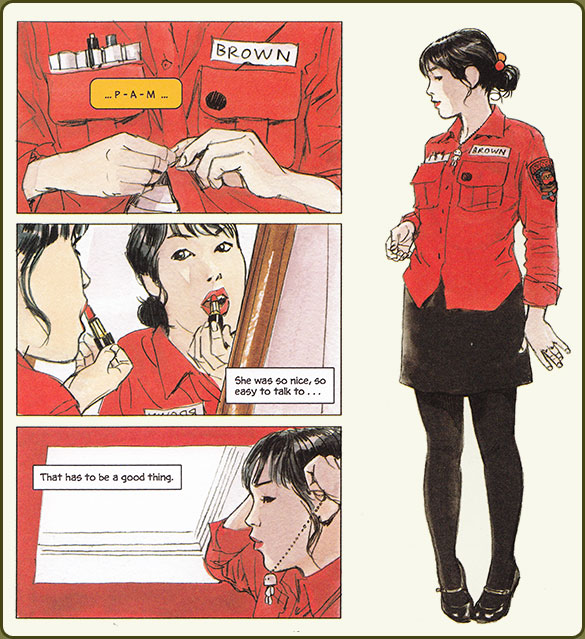 Introducing: Nao Brown, killer. Sort of.
Introducing: Nao Brown, killer. Sort of.
The Nao of Brown is a wonderful collection of visual and literary themes, marked by a compassionate visual sense and a deeply dialogical atmosphere. It's one of those books in which word and image conspire together in a harmony unusual for comics.66Generally a great comics work is far stronger in one of the two elements (visual and textual) and diminished in the other. Works like Gaiman's Sandman display verve and grace in their writing while the art suffers and is many times at odds with the written words. On the other hand we have something like Building Stories, whose design sense is beatific while its dialogue (while not bad) stutters by the comparison.
Dillon is not only an impressive illustrator and designer. His art always on every page aids his story, lending voice and colour to his characters' dialogue—and to Nao's narration. In a work in which the majority is filled with mundane conversation, Dillon invests his characters with expression, carriage, and posture such that their story would be incomplete if only left with their words. These are real people and they are rendered realistically save for the fact that Dillon captures them in the best possible moment—all in order of course that the reality their story should be validated by their presence.
The art is gorgeous, pencil and watercolour (though these days it can be hard to tell just how much is post-processed in Photoshop—as if it mattered in the end). Dillon couches his work in a rich tapestry of visual metaphor. Rich enough at least that there's plenty of fodder for those willing to put the work in to interpret him. Visual motifs abound. From the recurring use of the circle to foreign and foreign-esque cartoon characters, everything evokes. The pages bleed with purpose. Even Dillon's use of colour seems to bear on his meaning. Nao wears red. All the time. Every time. Until the times she doesn't. The Nao of Brown is such a delight to the eyes that I find myself wishing every book looked like this—despite loving much the more simple work of Chris Ware and Jason. Dillon's art breathes, it has life. And life is exactly what his story demands.
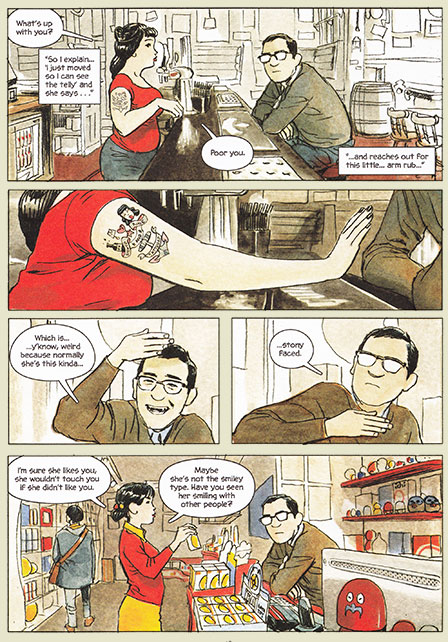 Check out this awesome page in which the bartender and Nao are juxtaposed, perhaps insinuating against Nao's apparent relationship to Steve.
Check out this awesome page in which the bartender and Nao are juxtaposed, perhaps insinuating against Nao's apparent relationship to Steve.
The Nao of The Nao of Brown is half-Asian, half-Caucasian and suffers from a violent interior life. She has a few friends but seems distant and distancing. She is afraid of herself and Dillon's exploration of her thought life gives merit to her fears. Generally, it would be about at this point in the book's description that I would slowly begin shutting down, losing interest. I realize that comics are a uniquely powerful medium for communicating the experience of the fracture of the inner self. Epileptic did it well. Swallow Me Whole did it well. It's a Bird... did it well. Even Fun Home and Are You My Mother? did it well in their own ways. The problem is that books about broken people tend to be mopey affairs. Really, Epileptic should carry a government label on its spine warning against combining with the consumption of alcohol—for such a terrible meeting would surely end in toasters and bathtubs and things too terrible to contemplate.
Happily, The Nao of Brown forges its own path. It's not The Pleasure of My Company, but it's probably not far off.77At least in terms of tone. It's nowhere in the neighbourhood of plot or purpose. For all of her fear and violence and actual, visceral anguish, Nao is a charming and beautiful young woman. I would want her as a friend. You probably might too. And from the outside, it's easy to see why few people realize that she's troubled any more than the next person on this sad, strange globe. In fact, she comes off at a glance better than a great number of us regular citizens. All of this means that Nao's story, while dark and terrible and innately concerned with the depravity of the human spirit, is sold with a buoyant gait and trudges along with the delightful pluck of a three-year-old in slightly too large rain boots, kicking leaves and stomping puddles. The book is a delicate admixture of sobriety and humour, and it's imbibing this concoction that carries the reader through, granting the pleasure and honour of coming to the place at which interpretation may begin.
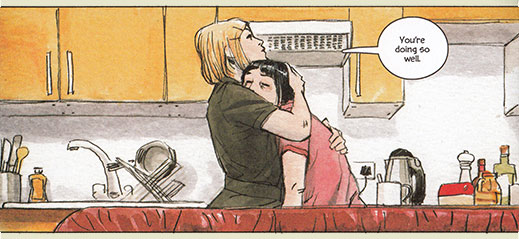
As with all books pregnant with complexity, The Nao of Brown requires dutiful attention and a steady hand—even when trying to piece together the overt story elements. (And that's before we even dream of answering the question of Dillon's purpose and goal.) After reading, desperate for someone to converse with on the book (since my wife wouldn't finish reading it for another three days), I glanced around at reviews and found critics incorrectly reading all sorts of things into the book. One suggests that Nao was the author of the Pictor stories. Another suggests that Nao is oblivious of Steve's affection for her while Nao herself pretty much plainly states otherwise. And then, I haven't found a single critic who correctly identifies who Dillon most likely pairs with Nao by story's close.88The author drops a tremendous tip in the first panel of page 202 if the rest of the story doesn't help spell it out. And if these details escape us, then legitimate understanding of the work's intent is almost necessarily elusive. And this is not to criticize those inattentive critics but simply to remark upon The Nao of Brown's glorious complexity.99I have struggled and wrestled with what Dillon has accomplished, and though I now think I get a lot of it, there are still questions and I cannot be certain that in the final evaluation I have gotten it right. This is a book that demands discussion. Maybe even heated discussion. Many readers, even, are split on the book's conclusion, debating whether Dillon's finale was a cop-out or not. I would suggest that whatever one's gut reaction to the climax and denouement, it should probably not be trusted. Dillon's weaving of his story is subtle and multifarious, not the kind of thing to be judged quickly.
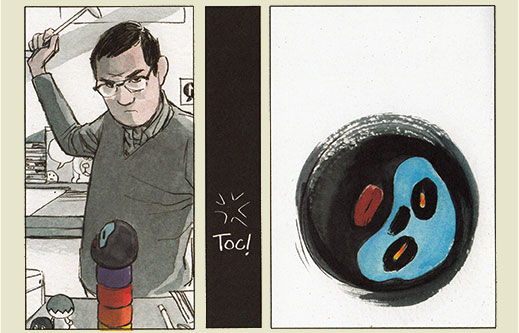 Role reversal.
Role reversal.
I am so very deeply grateful for this book. I am grateful to Self Made Hero for going to the trouble to make this artifact available a world away in nearly-sunny California. I am grateful to Glyn Dillon for putting so evident an effort into making his story come to life with such colour and in such a beautiful production. I am grateful for The Nao of Brown for assuring me that literary fiction holds a life beyond the confines of prose and can even sometimes make visitation to the shores of the comics medium. And I am thankful to Nao Brown for springing into pregnant life from the pages of her book—because I think the questions that fuel Nao's dreams and fears are the questions that haunt and help whole populations of this earth. And we need a cipher, someone to ask the question that we might scrabble for the answers.
Good Ok Bad features reviews of comics, graphic novels, manga, et cetera using a rare and auspicious three-star rating system. Point systems are notoriously fiddly, so here it's been pared down to three simple possibilities:
3 Stars = Good
2 Stars = Ok
1 Star = Bad
I am Seth T. Hahne and these are my reviews.
Browse Reviews By
Other Features
- Best Books of the Year:
- Top 50 of 2024
- Top 50 of 2023
- Top 100 of 2020-22
- Top 75 of 2019
- Top 50 of 2018
- Top 75 of 2017
- Top 75 of 2016
- Top 75 of 2015
- Top 75 of 2014
- Top 35 of 2013
- Top 25 of 2012
- Top 10 of 2011
- Popular Sections:
- All-Time Top 500
- All the Boardgames I've Played
- All the Anime Series I've Seen
- All the Animated Films I've Seen
- Top 75 by Female Creators
- Kids Recommendations
- What I Read: A Reading Log
- Other Features:
- Bookclub Study Guides










